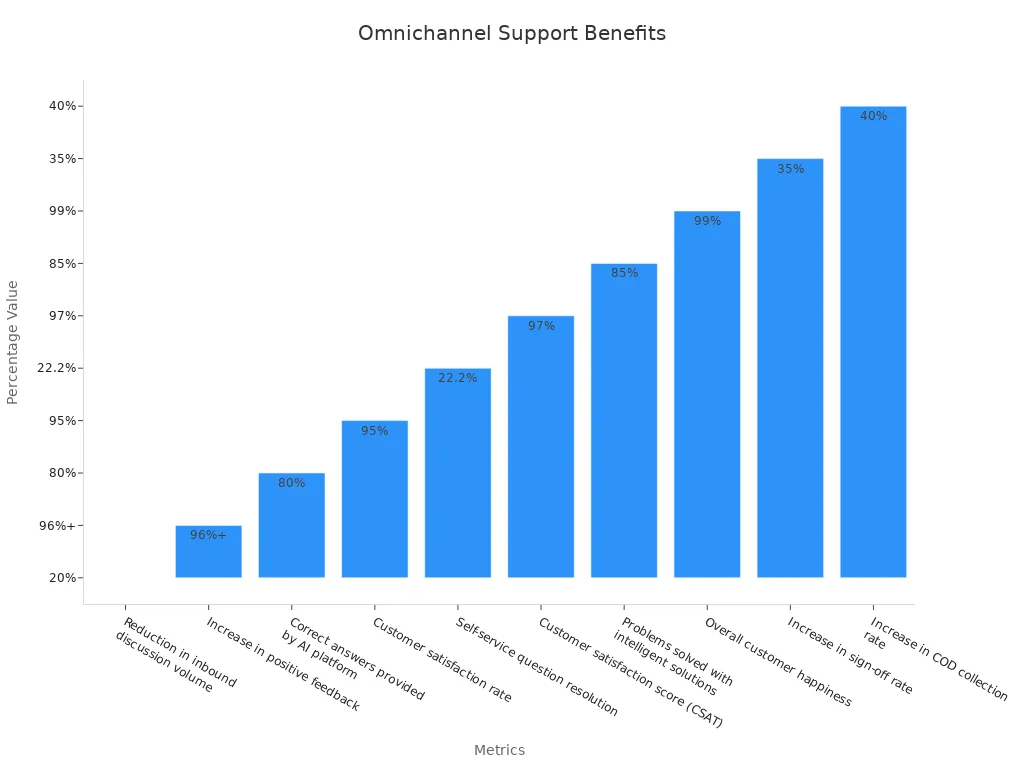Mastering Ecommerce Customer Experience for Better Engagement

In today’s fast-paced digital world, your ecommerce customer experience can make or break your business. Did you know that 44% of online shoppers return after a personalized shopping experience, even if cheaper options exist? And by 2025, 89% of businesses will compete mainly on customer experience, surpassing price and product quality. These numbers show how vital it is to create a seamless, engaging journey for your customers.

That’s where tools like Sobot come in. With Sobot Live Chat, you can enhance your ecommerce customer experience analysis by offering omnichannel support, personalized service, and instant responses. Sobot helps you connect with your customers on their terms, boosting engagement and building loyalty, ensuring your customers keep coming back.
What Is Ecommerce Customer Experience and Why It Matters
Defining Ecommerce Customer Experience
Ecommerce customer experience refers to the overall impression your customers have when interacting with your online store. It’s not just about the products you sell but how you make your customers feel throughout their journey. From browsing your website to completing a purchase, every touchpoint matters.
To deliver a great ecommerce customer experience, you need to manage customer data effectively. This means collecting and integrating information like purchase histories, support interactions, and browsing behavior across all platforms. For example:
- 76% of customers expect businesses to understand their needs and preferences.
- Amazon’s recommendation engine uses browsing data to suggest products, boosting conversions.
- Starbucks’ mobile app combines loyalty rewards, personalized promotions, and ordering features for a seamless experience.
By leveraging this data, you can create a personalized customer experience that keeps your shoppers engaged and coming back for more.
The Role of Ecommerce Customer Experience in Engagement and Retention
Your ecommerce customer experience plays a huge role in keeping customers engaged and loyal. When you prioritize customer satisfaction, you’re not just improving their experience—you’re driving business growth.
Take a look at the numbers:
| Metric | Evidence |
|---|---|
| Revenue Growth | Companies leading in CX can achieve roughly 2× the revenue growth of their peers. |
| Customer Retention | Improving CSAT can help retain 74% of customers for an additional year. |
| Operational Efficiency | A 1% improvement in FCR can reduce operating costs by 1%. |
| Brand Equity | High NPS correlates with better financial outcomes and customer lifetime value. |
When you focus on delivering excellent customer experiences, you’ll see higher retention rates, better customer lifetime value, and even faster revenue growth.
Overcoming Common Challenges in Ecommerce Customer Experience
Improving ecommerce customer experience isn’t always easy. Many businesses struggle with outdated technology, lack of feedback, or failing to identify opportunities for improvement. Here are some common challenges:
- Outdated systems that can’t keep up with customer demands.
- Automated responses that fail to address unique customer needs.
- Difficulty accommodating diverse customer backgrounds in cross-border ecommerce.

To tackle these issues, you need modern tools and strategies. Solutions like Sobot Live Chat can help you unify communication channels, provide personalized support, and streamline operations. By addressing these challenges head-on, you’ll create a smoother experience for your customers and set your business apart from competitors.
Ecommerce Customer Experience Analysis: Understanding Your Customers

Building Comprehensive Buyer Personas
Understanding your customers starts with building detailed buyer personas. These personas act as a blueprint for tailoring your ecommerce strategies to meet customer needs. To create accurate personas, you can use tools like surveys, feedback forms, and interviews. Analytical data, such as purchase history and browsing behavior, also plays a key role.
Here’s what to include in your personas:
- Demographics: Age, gender, income, location, and job title.
- Psychographics: Interests, values, and lifestyle choices.
- Behavioral Data: Purchase triggers, browsing habits, and influencing factors.
Did you know targeting audiences using buyer personas can increase website traffic by up to 210%? To stay relevant, revise your personas every 6 to 12 months. This ensures you adapt to changing market trends and customer preferences.
Mapping the Customer Journey for Better Insights
Customer journey mapping is essential for understanding how your customers interact with your brand. It’s not just about tracking their steps; it’s about uncovering their motivations and pain points. Combining qualitative methods, like customer interviews, with quantitative data, such as surveys, gives you a complete picture.
You can use different mapping techniques to refine your insights:
- Current State Maps: Document existing customer experiences.
- Future State Maps: Visualize the ideal journey.
- Day-in-the-Life Maps: Understand customer interactions throughout their day.
- Service Blueprints: Focus on customer service touchpoints.
By testing the journey from your customer’s perspective, you can identify areas for improvement. This approach ensures your ecommerce customer experience analysis is both actionable and effective.
Leveraging Data Analytics to Understand Customer Behavior
Data analytics is your secret weapon for decoding customer behavior. By analyzing metrics like bounce rates, exit rates, and time spent on product pages, you can uncover what drives or deters purchases. For example:
- Customers spending more time on product pages are likely weighing their options.
- High bounce rates may signal poor navigation or irrelevant content.
A/B testing is another powerful tool. One case study showed a 22.26% boost in conversion rates within six months by testing different strategies. Additionally, tracking cart abandonment rates (26% of shoppers abandon due to complex checkouts) can help you simplify processes and recover lost sales.
When you combine these insights, you’ll not only understand your customers better but also create a seamless buyer journey mapping experience that keeps them coming back.
Actionable Strategies to Enhance Ecommerce Customer Experience
Optimizing Website Design and Navigation
Your website is the first impression your customers get of your brand. A user-friendly website design can make all the difference in creating a better shopping experience. Imagine landing on a site where you can’t find what you’re looking for. Frustrating, right? That’s why optimizing your website’s design and navigation is crucial.
Here are some best practices to enhance your ecommerce customer service:
- Keep navigation simple and intuitive. Use breadcrumbs to show users where they are.
- Maintain a consistent layout across all pages. This helps customers feel at ease.
- Use descriptive anchor texts and differentiate visited links with colors.
- Include pagination and an HTML sitemap for better accessibility.
- Design for both skimmers and detail-seekers. Provide quick overviews while allowing access to in-depth information.
Performance metrics like load time, server response time, and mobile optimization also play a huge role. For instance, faster loading pages not only improve user satisfaction but also boost your search engine rankings. A lower time to first byte (TTFB) and fewer requests can significantly reduce bounce rates.
Pro Tip: Tools like Google PageSpeed Insights can help you measure and improve your website’s performance.
Personalizing the Shopping Experience with AI
Personalization is no longer a luxury—it’s a necessity. Customers expect tailored experiences that cater to their unique preferences. With ecommerce personalization software, you can deliver a personalized shopping experience that keeps your customers coming back.
AI-driven personalization works wonders in ecommerce. It tracks customer behavior, merges online and offline data, and uses predictive analytics to offer personalized recommendations. For example, a fast-growing ecommerce brand used AI to address low repeat purchase rates. The result? A 35% increase in customer retention and a 25% growth in repeat purchases.
Here’s how AI can enhance ecommerce customer experience:
- Behavioral tracking optimizes store layouts and boosts engagement.
- Unified profiles allow for hyper-personalized recommendations.
- Predictive analytics help forecast demand and manage inventory.
- Emotional connections foster trust and encourage repeat visits.
AI doesn’t just improve customer satisfaction—it drives revenue. Companies using AI-driven personalization report a 20% average sales increase. By making your customers feel understood, you create a better shopping experience that builds loyalty and trust.

Offering Omnichannel Support with Sobot Live Chat
In today’s digital age, customers interact with brands across multiple platforms. Offering omnichannel support ensures a seamless experience, no matter where your customers reach out. Sobot Live Chat makes this possible by unifying all communication channels into one platform.
With Sobot Live Chat, you can:
- Provide instant responses across websites, apps, and social media platforms like WhatsApp and Instagram.
- Use AI-powered tools to offer personalized support and resolve issues faster.
- Leverage built-in analytics to track over 150 indicators and optimize your ecommerce customer service.
The benefits of omnichannel support are clear. Businesses using tools like Sobot Live Chat see a 20% reduction in inbound discussion volume and a 96% increase in positive feedback. Additionally, intelligent solutions solve 85% of problems, leading to a 97% customer satisfaction score.

By integrating Sobot Live Chat into your ecommerce strategy, you can enhance ecommerce customer experience, boost engagement, and build lasting relationships with your customers.
Streamlining Checkout and Payment Processes
A smooth checkout process can make or break your ecommerce customer experience. Imagine this: a customer fills their cart with items they love, but the checkout process is so clunky they abandon their purchase. Frustrating, right? Streamlining the checkout process ensures your customers complete their orders without unnecessary hurdles.
Here’s why it matters: a streamlined checkout is efficient, user-friendly, and quick. By simplifying navigation and reducing the number of steps, you can boost transaction completion rates and encourage repeat purchases.
Pro Tip: “Employing the right tech solutions can streamline processes and increase conversions. Automation plays a crucial role in optimizing the checkout flow, reducing friction, and delivering a smoother customer journey.”
To achieve this, focus on these key strategies:
- Simplify the purchasing process by minimizing form fields and offering guest checkout options.
- Provide a variety of payment methods, including digital wallets like PayPal, Apple Pay, and Google Pay.
- Reduce shopping cart abandonment rates by displaying clear pricing, including shipping costs upfront.
- Use tools like Sobot Live Chat to assist customers in real-time if they encounter issues during checkout.
- Optimize for mobile users, as over 50% of ecommerce transactions now happen on smartphones.
A great example of this in action is Amazon’s one-click checkout. It eliminates unnecessary steps, making it incredibly easy for customers to complete their purchases. Businesses that adopt similar practices often see higher conversion rates and improved cash flow.
Additionally, integrating analytics tools can help you identify bottlenecks in your checkout process. For instance, if customers frequently abandon their carts at the payment stage, it might indicate a need for more payment options or a simpler interface.
By streamlining the checkout process, you’re not just improving ecommerce customer service—you’re creating a seamless experience that keeps customers coming back.
Collecting and Managing Customer Feedback
Your customers are your best critics and your biggest advocates. Collecting and managing customer feedback is essential for improving your ecommerce customer experience. It’s like having a roadmap that tells you exactly where to go to meet your customers’ needs.
Why is feedback so important? It helps you understand what’s working and what isn’t. Both positive and negative feedback provide valuable insights into customer satisfaction. For example, if multiple customers mention that your returns and exchanges process is too complicated, it’s a clear sign you need to simplify it.
Here’s how you can effectively manage customer feedback:
- Use tools like surveys, feedback forms, and live chat to gather input.
- Analyze feedback systematically to identify trends and areas for improvement.
- Prioritize changes based on the impact they’ll have on your ecommerce customer service.
- Collaborate across departments to implement feedback-driven improvements.
- Communicate updates back to your customers to show them their opinions matter.
Did You Know? Regularly updating customers about changes made based on their feedback fosters loyalty and trust.
Sobot Live Chat can play a pivotal role here. Its built-in analytics allow you to track customer interactions and gather real-time feedback. For instance, if a customer mentions an issue during a chat, you can log it immediately and address it proactively. This not only enhances your ecommerce customer service but also builds stronger relationships with your audience.
Take Starbucks as an example. They actively collect feedback through their app and use it to improve their offerings. When customers suggested adding more dairy-free options, Starbucks responded by expanding their menu. This approach not only improved customer satisfaction but also strengthened brand loyalty.
By managing customer feedback effectively, you’re not just solving problems—you’re showing your customers that their voices matter. And that’s a surefire way to build trust and long-term loyalty.
Measuring and Monitoring Success in Ecommerce Customer Experience
Tracking the success of your ecommerce customer experience is essential for growth. Without clear metrics, it’s hard to know what’s working and what needs improvement. By measuring key performance indicators (KPIs), you can pinpoint areas to refine and boost customer loyalty.
Key Metrics to Improve Ecommerce Customer Experience
To measure ecommerce customer experience effectively, focus on metrics that reveal customer satisfaction, loyalty, and ease of interaction. These KPIs provide actionable insights into your ecommerce operations management:
| KPI | Description |
|---|---|
| Customer Satisfaction Score | Measures how satisfied customers are with their experience. |
| Net Promoter Score | Gauges customer loyalty and likelihood to recommend the brand. |
| Customer Retention Rate | Indicates the percentage of customers who continue to do business over a specific period. |
| Customer Effort Score | Assesses how easy it is for customers to interact with the business. |
| Customer Churn Rate | Reflects the rate at which customers stop doing business with the company. |
For example, Net Promoter Score (NPS) helps you understand how likely customers are to recommend your brand. Promoters often spend more and stay longer, while detractors signal areas needing improvement. Similarly, Customer Effort Score (CES) highlights how simple it is for customers to complete tasks like checkout or returns. Lower effort scores often lead to higher retention rates.

Pro Tip: Use tools like Sobot Live Chat to collect real-time feedback and calculate metrics like CSAT and CES. This helps you improve ecommerce customer experience by addressing pain points quickly.
Tools for Ecommerce Customer Experience Analysis
Analyzing ecommerce customer service requires the right tools. These platforms help you track user behavior, measure KPIs, and optimize your ecommerce operations management.
- Google Analytics: Tracks traffic, user behavior, and conversion rates, offering insights into website speed and load time.
- Shopify Analytics: Provides dashboards and reports on sales and customer behavior.
- BigCommerce: Integrates with BI tools for a comprehensive view of ecommerce operations management.
- Crazy Egg: Visualizes customer interactions on your website, helping you identify areas for improvement.
- Hotjar: Offers surveys and heatmaps to understand user behavior.
- Sobot Live Chat: Combines omnichannel support with built-in analytics, tracking over 150 indicators to optimize ecommerce customer service.

For instance, Sobot Live Chat’s analytics can reveal trends in customer inquiries, helping you refine your support strategy. If you notice frequent questions about shipping policies, you can update your website to address these concerns proactively.
Did You Know? Businesses using advanced analytics tools like Sobot Live Chat often see a 38% increase in conversion rates due to improved customer interactions.
Using Feedback to Continuously Enhance Customer Experience
Feedback is your secret weapon for improving ecommerce customer service. It’s not just about collecting opinions—it’s about acting on them. A structured feedback loop ensures you’re always adapting to meet customer needs.
Here’s how to create an effective feedback loop:
- Collect Input: Use surveys, reviews, and live chat to gather customer insights.
- Analyze Feedback: Identify recurring issues and opportunities for improvement.
- Take Action: Implement changes based on the insights you’ve gathered.
- Follow Up: Communicate updates to customers, showing them their feedback matters.
For example, if customers mention slow website speed and load time, prioritize optimizing your site’s performance. Tools like Google PageSpeed Insights can help you identify bottlenecks. Similarly, Sobot Live Chat allows you to log customer concerns in real time, ensuring quick resolutions.
Fact: 73% of customers will switch to a competitor after multiple bad experiences. Acting on feedback not only improves ecommerce customer experience but also boosts customer loyalty.
By continuously refining your processes based on customer insights, you’ll create a shopping experience that keeps customers coming back.
Future Trends in Ecommerce Customer Experience

The Role of AI and Machine Learning in Customer Experience
AI and machine learning are transforming how you interact with customers. These technologies analyze real-time data to predict customer needs, personalize experiences, and automate repetitive tasks. For example, AI can recommend products based on browsing history or even predict when a customer might need assistance.
| Aspect | Benefit |
|---|---|
| Improved Customer Satisfaction | AI delivers quick, context-aware responses, boosting loyalty. |
| Enhanced Agent Productivity | Automating routine tasks lets agents focus on complex issues. |
| Data-Driven Decision-Making | Real-time insights help refine strategies and improve customer engagement. |
Did you know 70% of CEOs believe generative AI will redefine how businesses create value within three years? AI doesn’t just improve efficiency—it helps you build stronger connections with your customers. By balancing personalization with privacy, as experts like Tia White from AWS suggest, you can meet rising expectations while respecting customer data.
Augmented Reality and Virtual Shopping Experiences
Augmented reality (AR) and virtual shopping are reshaping ecommerce. Imagine trying on clothes virtually or seeing how furniture fits in your living room before buying. These features make shopping more interactive and reduce uncertainty.
- AR encourages customers to explore product features, like rotating 3D models or zooming in on details.
- Virtual try-ons help customers feel confident about their purchases, reducing return rates.
- Statistics show AR experiences are 200% more engaging than traditional methods, with 61% of shoppers preferring retailers that offer AR.
| Evidence | Description |
|---|---|
| Higher Engagement | AR keeps customers on your site longer, improving SEO rankings. |
| Reduced Return Rates | Virtual try-ons minimize uncertainty, leading to fewer refunds. |
| Increased Loyalty | Shoppers are more likely to return to stores with AR features. |
By adopting AR, you not only enhance customer satisfaction but also create a memorable shopping experience that keeps them coming back.
Sustainability and Ethical Practices as Key Drivers
Sustainability is no longer optional—it’s a priority. Customers now expect businesses to adopt eco-friendly practices, from using recyclable packaging to reducing carbon footprints. Many are even willing to pay more for sustainable products.
Note: Brands like Levi’s and Target are leading the way by promoting ethical commerce and offering recycling programs.
| Evidence Type | Description |
|---|---|
| Consumer Demand | Shoppers increasingly prefer sustainable ecommerce options. |
| Competitive Advantage | Ethical practices give brands an edge in the market. |
| Supply Chain Emissions | Up to 95% of a company’s carbon footprint comes from its supply chain. |
By integrating sustainable practices into your business, you not only attract eco-conscious customers but also position yourself as a leader in corporate responsibility. This approach drives long-term growth and strengthens your brand’s reputation.
Prioritizing ecommerce customer experience isn’t just a nice-to-have—it’s a game-changer. Companies that excel in this area often see revenues 4-8% above their market. Why? Because happy customers stick around, spend more, and even recommend your brand to others.
Here’s a quick look at the impact of focusing on customer experience:
| Statistic | Impact on Ecommerce Customer Experience |
|---|---|
| 84% of companies improving customer experience report revenue growth. | Strong link between CX and financial success. |
| 86% of buyers are willing to pay more for a great experience. | Better experiences lead to higher order values. |
| A 5% increase in retention can boost profits by 25% to 95%. | Retention drives significant financial gains. |
To stay ahead, adopt tools like Sobot Live Chat to provide personalized, omnichannel support. Combine this with AI-driven insights and streamlined processes to create a seamless shopping journey. And don’t forget to embrace future trends like AR and sustainability to keep your brand competitive.
When you prioritize customer experience, you’re not just meeting expectations—you’re setting new standards.
FAQ
What is ecommerce customer experience, and why is it important?
Ecommerce customer experience is how customers feel when interacting with your online store. It includes everything from website design to customer support. A great experience builds trust, increases loyalty, and boosts sales. Happy customers are more likely to return and recommend your brand to others.
How does Sobot Live Chat improve customer engagement?
Sobot Live Chat connects with customers instantly across multiple platforms. It offers personalized support, AI-powered tools, and real-time responses. These features make customers feel valued and understood, increasing satisfaction and loyalty. Plus, it simplifies communication, so your team can focus on solving problems faster.
What are the benefits of omnichannel support?
Omnichannel support ensures customers get help wherever they are—on your website, social media, or apps. It creates a seamless experience, reduces response times, and improves satisfaction. Tools like Sobot Live Chat unify all channels, so you never miss a customer inquiry.
How can I measure the success of my ecommerce customer experience?
Track metrics like Customer Satisfaction Score (CSAT), Net Promoter Score (NPS), and Customer Retention Rate. These KPIs show how happy and loyal your customers are. Tools like Sobot Live Chat provide built-in analytics to help you monitor and improve your performance.
Why is personalization important in ecommerce?
Personalization makes customers feel special. It uses data to recommend products, tailor promotions, and create unique shopping experiences. This approach increases engagement, boosts sales, and builds loyalty. Customers are more likely to return when they feel understood and valued.
See Also
Enhancing Sales Through Ecommerce Live Chat Solutions
Increasing Customer Satisfaction With E-commerce Chatbots
Excelling in Live Chat Within Retail Businesses
